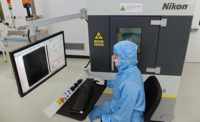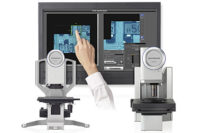
The application of microscopy to manufacturing challenges demands a familiarity and understanding of technological issues in addition to the manufacturing environment itself. On a daily basis, manufacturing and quality professionals are faced with the necessity of obtaining and analyzing microscopic data in order to maximize product quality in a speedy and effective manner. The multiple applications of conventional microscopy have always provided manufacturing a more effective analytical tool to obtain data for analysis than using visual tools such as magnifiers or magnifying lens. Ultimately, applying conventional photography to microscopy has further extended the need to capture the microscopic data for analysis.
However, the time required to process and share conventional photography has continued to negatively impact and hinder manufacturing's bottom line. Today, the increasing use of digital microscopy as an integral part of the whole is an exciting development for manufacturers and quality professionals. Digital microscopy increases the speed quality professionals obtain and analyze data.
History
The integration of conventional film photography with the microscope provided the consumer an image capture solution that was used, over time, for analysis, presentation and storage. It was a benchmark in both worlds of photography and microscopy. However, while conventional film images could be scanned and digitized, these same additional steps lowered quality and were time-consuming. Conventional photography integrated with the microscope did not address the growing requirement for easy, reliable transmission of valid images to a wide number of operators and applications.Furthermore, conventional photographic images required layers of handling and processing in use with evolving and changing software analysis applications. While operators frequently scanned and manipulated conventional photographic images via a computer to produce diverse digital images, the basic need for immediate visualization and then capture of microscopic images pushed the development curve of digital microscopy.
The advent of digital microscopy, a standard light microscope combined with a digital camera and applicable software, permitted microscopic images to immediately be displayed on a computer screen. Digitized microscopic images could be reconstructed, analyzed and displayed in real time on a computer monitor. Digital image tools quickly increased image resolution and storage capabilities for consumers. More significantly, the new digital techniques and demands opened the development doors to faster and more accurate automated software analysis.

Digital Imaging's Impact
Digital imaging began to transform business processes. Professionals could easily capture images for training and documentation. Industrial teams shared images electronically via e-mail, Web sites or Web conferencing sites. Digital imaging began to open the doors to immediate review, analysis, collaboration and sharing. With the new technology and application improvements, digital images were e-mailed for consultation and discussion, incorporated into other digital documents, exported to image analysis systems, or saved for storage and later, archived.While integrating digital equipment with existing microscopy equipment produced benefits, the implementation was often complex: cables, connectors and disparate hardware. Frequently, equipment was sold and integrated separately, leaving more work in the organization for a professional team. Increased troubleshooting accompanied the new capabilities and the uncomfortable fit began to drive the development of an integrated digital microscopy device. Necessity became the mother of invention.
Integrated digital microscopy devices eliminate or reduce the technological complexity surrounding digital capture from optical microscopy equipment by circumventing the need to connect each microscope to a separate digital imaging device and instead, incorporating the device into the microscope's assembly. This single evolution of digital microscopy provided simpler tools with more flexibility for applications and needs.

Modern Microscopy
Today, integrated microscopy systems may incorporate a monitor or display unit and storage device. The monitor encourages immediate team collaboration. The storage device facilitates storage and sharing of the collected images and has archiving capabilityas well.
Whereas digital imaging enabled greater collaboration and real-time imaging, today's integrated devices simplify the implementation and installation in manufacturing environments. Operations are simplified by removing common points of failure and reinventing them as integral to the microscope assembly.
Digital microscopy has begun to enhance manufacturers' ability to document material and process conformance. An automotive supplier can now document weld-joint information using an integrated digital microscopy system. The supplier can investigate and evaluate techniques to improve material conformance and meet customer information requirements.
Operators can position welded samples in front of the optics, obtaining a digital image. Operators can select several weld points using the monitor before the software automatically calculates standard measurements. The measurement information and a weld image are archived for future use and documentation. Finally, the supplier sends part-related information obtained via digital microscopy with each shipment to document manufacturing compliance.
Recently, a Michigan-based automotive tubing supplier enhanced product quality and exceeded customer expectations through the use of an integrated digital microscopy system application. The supplier needed to confirm the presence and measurement of two glass layers in a tubing assembly. Previous activities were proven to be time-consuming and error-prone because of operator interpretation. The team reviewed the requirements and developed a process to consistently and quickly meet manufacturing objectives.
The newly implemented system used light to leverage the different refractive properties of the glass. After the tube was correctly illuminated, operators were able to capture and analyze a digital image. Using microscopy software, the team finished the process by archiving the image, the measurements and the calculations for retrieval and customer review.
While microscope advancements were helpful to both of these manufacturers, significant improvements also were possible because of software processing advancements. Software continues to enhance microscopy's use to manufacturers. This and microscopy equipment's flexibility, functionality and accuracy continue to grow microscopy's role as one of the primary evaluation methods of quality control programs for condition and quality appraisal. Q
Tech Tips
• The multiple applications of conventional microscopy have always provided manufacturing an effective analytical tool to obtain data for analysis.• Integrated digital microscopy devices eliminate or reduce the technological complexity surrounding digital capture from optical microscopy equipment.
• Digital microscopy has begun to enhance manufacturers' ability to document material and process conformance.


